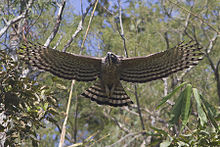| Mountain hawk-eagle | |
|---|---|

| |
| An adult mountain hawk-eagle in flight, West Bengal, India | |
| Scientific classification | |
| Domain: | Eukaryota |
| Kingdom: | Animalia |
| Phylum: | Chordata |
| Class: | Aves |
| Order: | Accipitriformes |
| Family: | Accipitridae |
| Genus: | Nisaetus |
| Species: | N. nipalensis
|
| Binomial name | |
| Nisaetus nipalensis | |
| Subspecies[3] | |
| |
| Synonyms | |
| |
The mountain hawk-eagle (Nisaetus nipalensis) or Hodgson's hawk-eagle, is a large bird of prey native to Asia. The latter name is in reference to the naturalist, Brian Houghton Hodgson, who described the species after collecting one himself in the Himalayas.[4] A less widely recognized common English name is the feather-toed eagle.[5] Like all eagles, it is in the family Accipitridae. Its feathered tarsus marks this species as a member of the subfamily Aquilinae. It is a confirmed breeding species in the northern part of the Indian subcontinent, from India, Nepal (hence the epithet nipalensis) through Bangladesh to Thailand, Taiwan, Vietnam and Japan, although its distribution could be wider still as breeding species.[1][6][7] Like other Asian hawk-eagles, this species was earlier treated under the genera of Spizaetus but genetic studies have shown this group to be paraphyletic, resulting in the Old World members being placed in Nisaetus (Hodgson, 1836) and separated from the New World species.[8][9][10][11] As is typical of hawk-eagles, the mountain hawk-eagle is a forest dwelling opportunistic predator who readily varies its prey selection between birds, mammals and reptiles along with other vertebrates.[12] Although classified currently as a least-concern species due its persistence over a rather wide distribution, this species is often quite rare and scarce and seems to be decreasing, especially in response to large-scale habitat degradation and deforestation.[1][6][13]
- ^ a b c BirdLife International (2021). "Nisaetus nipalensis". IUCN Red List of Threatened Species. 2021: e.T22696153A200288705. Retrieved 13 November 2021.
- ^ Hodgson, B.H. (1836). "Summary description of some new species of Falconidae". Journal of the Asiatic Society of Bengal: 227–231.
- ^ IOC World Bird List 10.2 (Report). World Bird Names. doi:10.14344/ioc.ml.10.2.
- ^ Cocker, Mark; Inskipp, Carol (1988). A Himalayan ornithologist: the life and work of Brian Houghton Hodgson. Oxford: Oxford Univ. Pr. ISBN 978-0-19-857619-8.
- ^ Ripley, Sidney D. (1982). A synopsis of the birds of India and Pakistan: together with those of Nepal, Bhutan, Bangladesh and Sri Lanka (2 ed.). Bombay: Bombay Natural History Soc. ISBN 978-0-19-562164-8.
- ^ a b Ferguson-Lees, James; Christie, David A. (2001). Raptors of the World. Houghton Mifflin Harcourt. ISBN 978-0-618-12762-7.
- ^ Grimmett, Richard; Inskipp, Carol; Inskipp, Tim; Inskipp, Timothy P., eds. (2012). Birds of India, Pakistan, Nepal, Bangladesh, Bhutan, Sri Lanka, and the Maldives. Princeton field guides (2 ed.). Princeton, NJ: Princeton University Press. ISBN 978-0-691-15349-0.
- ^ Helbig, Andreas J.; Kocum, Annett; Seibold, Ingrid; Braun, Michael J. (April 2005). "A multi-gene phylogeny of aquiline eagles (Aves: Accipitriformes) reveals extensive paraphyly at the genus level". Molecular Phylogenetics and Evolution. 35 (1): 147–164. doi:10.1016/j.ympev.2004.10.003. PMID 15737588.
- ^ Haring, E.; Kvaløy, K.; Gjershaug, J.-O.; Røv, N.; Gamauf, A. (November 2007). "Convergent evolution and paraphyly of the hawk-eagles of the genus Spizaetus (Aves, Accipitridae) – phylogenetic analyses based on mitochondrial markers". Journal of Zoological Systematics and Evolutionary Research. 45 (4): 353–365. doi:10.1111/j.1439-0469.2007.00410.x. ISSN 0947-5745.
- ^ Gamauf, A.; Gjershaug, J. O.; Kvaløy, K.; Røv, N.; Haring, E. (1 January 2005). "Molecular phylogeny of the hawk-eagles (genus Spizaetus)". Zoologische Mededelingen. 79 (3): 179–180. ISSN 0024-0672.
- ^ Amadon, Dean (July 1953). "Remarks on the Asiatic hawk-eagles of the genus Spizaetu". Ibis. 95 (3): 492–500. doi:10.1111/j.1474-919X.1953.tb00709.x. ISSN 0019-1019.
- ^ Naoroji, Rishad (2006). Birds of prey of the indian subcontinent. London: Christopher Helm. ISBN 978-0-7136-6324-2.
- ^ Asai, Shigeki; Yamamoto, Yoshihiro; Yamagishi, Satoshi (June 2006). "Genetic diversity and extent of gene flow in the endangered Japanese population of Hodgson's hawk-eagle, Spizaetus nipalensis". Bird Conservation International. 16 (2): 113–129. doi:10.1017/S0959270906000050. ISSN 0959-2709.
